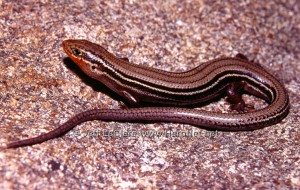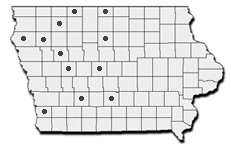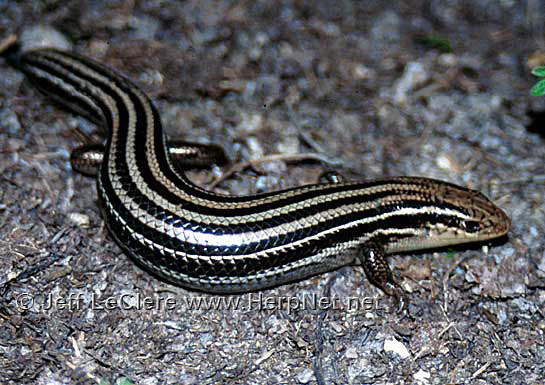Prairie Skink (Plestiodon septentrionalis)
by Jeff LeClere

Status
Species of Greatest Conservation Need. The former scientific name for this skink was Eumeces septentrionalis.
Description
The prairie skink reaches lengths of 5 1/4 to 8 3/4 inches, total length (Conant and Collins 1991). The body scales are smooth and uniform giving the lizard a shiny appearance. Adults are tan or brown on the back, becoming darker on the sides. There are two very thin white stripes on the sides. The back may be unmarked except for two very thin, interrupted black stripes or two large black stripes that are as wide as the spaces between them. The head is unmarked.
The males develop a bright orange coloration on the labial scales during the breeding season. Young have bright blue tails that fade as they become adults. Prairie skinks differ from the similar common five-lined skink in that the light bands are as wide as the black bands on the sides. Common five-lined skinks have very thin light bands on a dark ground color.
Subspecies
The subspecies of prairie skink in Iowa is the northern prairie skink, Plestiodon septentrionalis septentrionalis.
Range

The prairie skink has the largest Iowa range of all five lizard species. They have been reported from basically the western half of Iowa, but there are probably small, isolated colonies scattered about eastern Iowa as well.
Habitat
Prairie skinks come from sandy prairie areas, open grasslands with loose soils, and open rocky areas. They are often found in open grasslands adjacent to marshes or lakes. They seem to be drawn to rocky areas; boulders sunken in the ground, rock piles, logs, or junk.
Habits
Prairie skinks emerge from their winter dormancy in April. They bask atop rocks or logs and actively forage for their food. They are diurnal, but they often take refuge under rocks or logs during the hottest parts of the day in mid-summer. Prairie skinks are accomplished burrowers, and may construct burrows with entrances that form shallow dugouts under rocks or similar cover.
Breeding occurs in spring. The male grasps the skin of the female’s neck during copulation. All are oviparous laying about 10 eggs sometime in June in small excavations under forms of cover such as rocks logs or boards. I have observed a few prairie skink nests under railroad ties in Minnesota and Iowa. Females guard the eggs and eat the ones that have spoiled. The eggs hatch in August.
All of Iowa’s lizards are quick and rely on speed to escape when they are out and about. Skinks look like small snakes slithering through the brush as they move their bodies in a very serpentine way when they run. One must use caution when trying to capture skinks. Often one will end up with nothing but a wriggling tail as the lizard scoots off to safety. Skinks may break their tails off by themselves by pushing it against a solid structure. The tail will regenerate, but it will have no pattern, will have slightly different scalation, and will never be as long as the original one.
Prairie skinks overwinter underground in burrows they dig, or abandoned mammal burrows. Adults usually begin overwintering in September, and juveniles a bit later. Scott and Reuben (1937) report a football-sized group of prairie skinks overwintering in a refuse pile in Palo Alta County in February. There were 52 skinks in the mass.
Food
All five species of Iowa’s lizards eat small invertebrates such as crickets, grasshoppers, beetles, spiders, caterpillars, which they chase down and eat. They mash their food up with their strong jaws before swallowing their prey.
